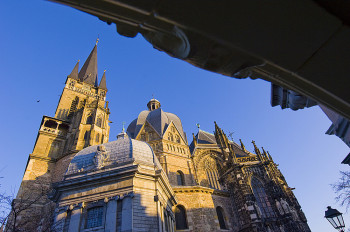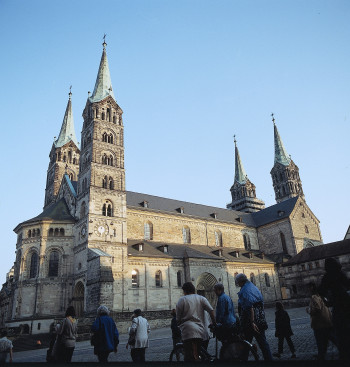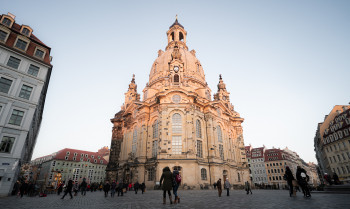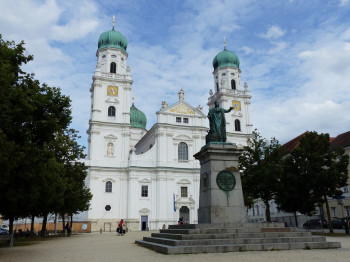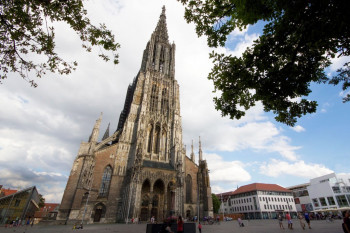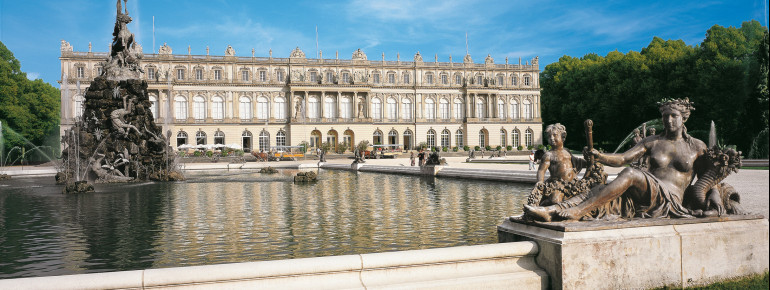Large domes, high towers, elaborate frescoes and painted windows - the numerous houses of worship in Germany leave not only devout Christians amazed. Whether cathedral, minster or small pilgrimage church, the impressive buildings bear witness to an eventful history that goes back centuries, in some cases even more than a thousand years, and are definitely worth a visit. We present a selection of the most beautiful churches in Germany.
Aachen Cathedral
In Aachen, you will follow in the footsteps of Charlemagne, who had Aachen Cathedral built as early as the 8th century. Since its completion in 803, the cathedral has been repeatedly expanded and rebuilt, so that elements from numerous eras can be found here.
In addition to the bones of Charlemagne and the four Aachen shrines, the cathedral treasury and the colourful windows of the choir hall, the so-called "Glass House", attract numerous visitors and pilgrims to Aachen Cathedral. Aachen Cathedral has been a UNESCO World Heritage Site since 1978. During the holiday season, the Aachen Christmas Market takes place directly in front of the cathedral.
Bamberg Cathedral
The Imperial Cathedral of St. Peter and St. George in Bamberg was built more than 1,000 years ago, but burned down twice. The imposing church, which today overlooks Bamberg's old town with its four towers on the Domberg, is the third building of the imperial cathedral and dates back to the early 13th century.
Due to its repeated reconstruction, the cathedral cannot be clearly attributed to one era. However, there are many stylistic elements of the late Romanesque in the east building and early Gothic in the west building. Among the most famous sights in the cathedral are the high grave of the imperial couple Kunigunde and Heinrich II, the papal tomb of Clemens II and the Bamberg Horseman.
Berlin Cathedral
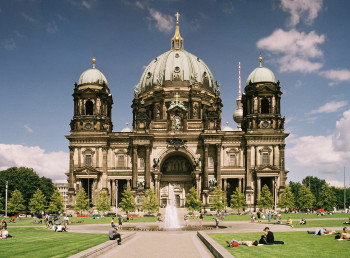
The Berlin Cathedral is located in the historic center of Berlin and is one of the most famous attractions of the German capital. The striking building with its huge dome, which used to be even higher, is often referred to as the "entrance gate to the Museum Island". Even though the monument church part no longer exists and only the baptismal and marriage churches as well as the sermon church still stand, the original tripartite structure of the baroque church is still clearly visible.
A highlight of the cathedral tour is the dome walkway. The climb of 270 steps is rewarded at a height of 50 metres with a magnificent 360° panoramic view of the city. From up here you can see the Museum Island, the TV Tower, the Reichstag, the street Unter den Linden and the Humboldt Forum.
Dresden's Frauenkirche
The Dresden Frauenkirche (Church of Our Lady) at the Neumarkt is the heart of Dresden's old town and, along with the Semper Opera House and the Zwinger, probably the most famous sight in the Saxon capital. The Frauenkirche was already built in the 11th century and thus looks back on a thousand-year history, which was quite extraordinary. However, the church only got its famous dome in the 18th century.
After the Frauenkirche was completely destroyed shortly before the end of the Second World War, the mountain of rubble remained for more than forty years. The ruins were intended as a reminder of the destruction of Dresden and over the years became a symbol of the peace movement. It was not until the 1990s that the church was rebuilt from the old rubble in its baroque beauty. The historic materials can still be clearly recognized in the dark and light-colored stones.
Erfurt Cathedral
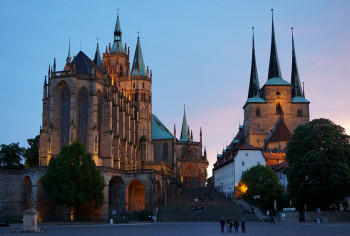
The Erfurt Cathedral is located in the heart of the Thuringian state capital and is visible from afar. A large flight of steps leads up to the Domberg, on which the Cathedral of St. Mary and, to the right, the Church of St. Severin are enthroned above the cathedral square (Domplatz). The two churches are the city's landmark and also give the Erfurt Christmas market, which takes place every year during Advent on the Cathedral Square, its festive ambience.
The first Episcopal church on the site of today's cathedral was built as early as the middle of the 8th century. The present building with its high Gothic choir, late Gothic ambulatory and Romanesque tower area is the successor to this first church.
Erfurt Cathedral is famous for its "Gloriosa" in the middle tower. It is the world's largest free-swinging bell of the Middle Ages. The glass paintings on the medieval cathedral windows are also impressive.
Cologne Cathedral

Cologne Cathedral is not only the landmark of the Rhine metropolis, but also one of the most visited sights in Germany. The foundation stone for this imposing Gothic building was laid in 1248 because the old cathedral was not magnificent enough for the bones of the Three Wise Men transferred by the archbishop. The relics quickly made Cologne one of the most important pilgrimage sites in Europe.
However, Cologne Cathedral was not completed until 1880, i.e. after around 600 years of construction. With its two towers over 157 metres high, it was the tallest building in the world at the time. Fun Fact: The north tower is a few centimetres higher than the south tower! Since 1996, Cologne Cathedral has been a UNESCO World Heritage Site.
If you are interested in precious relics and treasures, you should pay a visit to the cathedral treasury in the medieval vaulted cellars under the cathedral. Another highlight is the ascent of the tower. On the south tower there is a viewing platform at a height of 97 meters, from which you have a great view over the city.
Limburg Cathedral
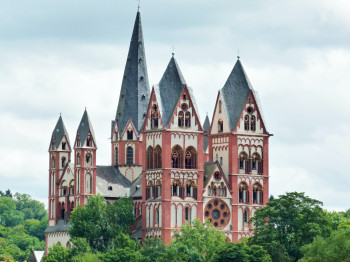
Anyone travelling to Limburg an der Lahn can see St. George's Cathedral from afar. Perched on a rock, Limburg's landmark towers over the old town with its seven red and white spires. Limburg Cathedral is accessible on several levels. In the Middle Ages, processions even took place in the arcades of the galleries.
The church was built at the end of the 12th century and then consecrated in 1235, initially as a collegiate church. It did not become a cathedral until 1827, when the diocese of Limburg was founded. The imposing building on the rock on the Lahn belongs to the Rhenish late Romanesque period. The high, light-flooded interior, on the other hand, is designed in the Gothic style.
Mainz Cathedral & St. Stephen's
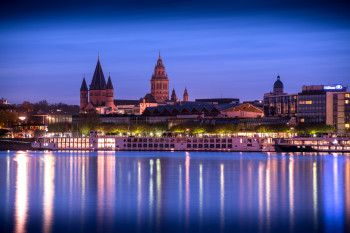
The imposing Mainz Cathedral has shaped the cityscape of Mainz for around 1,000 years. The foundation stone for St. Martin's Cathedral was laid as early as 975. However, when the cathedral was to be consecrated around 30 years later, it burned down, so that it was not completed in its basic form, which still exists today, until 1239. The fire, however, remained a problem. Over the centuries, the cathedral burned seven times.
The enormous building made of red sandstone consists of three naves, two choirs and numerous chapel annexes. The cathedral is still characterized by the original Romanesque architecture, but Gothic and Baroque elements can also be found. Most striking are the spires in the west, which were built in rococo style during the reconstruction after a cathedral fire around 1770.
>> More information about Mainz Cathedral
If you are in Mainz, you should also pay a visit to the smaller church St. Stephan, which is only a 10-minute walk away from the cathedral. What makes the church so special are its windows, which were created by the famous artist Marc Chagall. They bathe the entire interior in blue light, creating a very special atmosphere.
Passau Cathedral
With its gleaming white façade and blue-green domes, St. Stephen's Cathedral sits enthroned on the highest point of Passau's old town. Built in the 13th century, the originally Gothic cathedral was rebuilt in the Baroque style after the city fire of 1662. Although the exterior still retains the late Gothic elements of the eastern section, the interior features lavish stuccowork and altarpieces from the Italian High Baroque period, making it the largest Baroque church interior north of the Alps.
Passau Cathedral is also famous for its organ. With almost 18,000 pipes, it is the largest Catholic church organ in the world and the largest organ in Europe. The largest pipe is more than 11 metres long and weighs over 300 kilos. If you want to experience this impressive instrument in action, you should visit one of the cathedral organ concerts, which take place almost daily in summer.
>> More information about the Passau St. Stephen's Cathedral
Speyer Cathedral
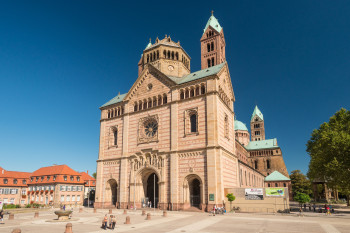
When it was completed in 1061, Speyer Cathedral was the largest church building in the world at that time and it is still considered the largest preserved Romanesque church in the world. Besides the size, the crypt is also impressive. It dates back to the earliest construction phase of the cathedral and was consecrated as early as 1043. Here are the tombs of numerous emperors and kings. Some of the stone sarcophagi are still preserved in their original condition.
There is a viewing platform on the southwest tower of the Cathedral of St. Mary and St. Stephen. About 300 steps take you up to a height of 60 meters. From there you have a great view over the city of Speyer and the Rhine plain.
Trier Cathedral
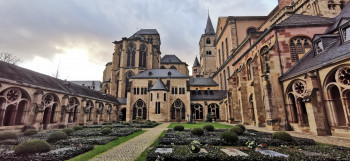
The history of Trier Cathedral goes back some 1700 years to late antiquity. The first large basilica was built on the site of today's cathedral in the early 4th century. Its outer walls still form the core of the cathedral today. This makes Trier Cathedral the oldest church in Germany.
Right next to St. Peter's Cathedral is the Liebfrauenkirche (Church of Our Lady). The two churches are connected by a cloister and have been part of the UNESCO World Heritage Site of Trier since 1986.
Ulm Minster
Ulm Minster is famous above all for its west tower, which at 161.53 metres is the highest church tower in the world. If you want to climb it, you need to be in good shape. To get to the top viewing platform, you have to climb 768 steps. But the ascent is rewarded with a magnificent panorama. In good weather, the view even reaches as far as to the Alps.
But also the interior of the minster is quite impressive. There is a reason why it took more than 200 years to build. Because there was never a sovereign or bishop in Ulm, the cathedral was built solely by the citizens of the city. However, the first major construction phase from 1377 to 1543 had to be stopped prematurely after the Reformation for economic reasons. The church was not completed until the end of the 19th century. Today the minster in Ulm is the largest protestant church in Germany.
Pilgrimage Church of Wies in the Pfaffenwinkel
It doesn't always have to be the big, imposing cathedral. Small pilgrimage churches are also well worth a visit. For example, the Pilgrimage Church of Wies (Wieskirche) in the Pfaffenwinkel is a true rococo jewel. Inside the small church, lavish ceiling frescoes, gilded garlands and opulent stucco work await you.
The pilgrimage church of the Flagellated Saviour on the Wies - or just called "The Wies" - was added to the list of UNESCO World Heritage Sites in the 1980s and is still a popular destination for pilgrims and pilgrims today.


